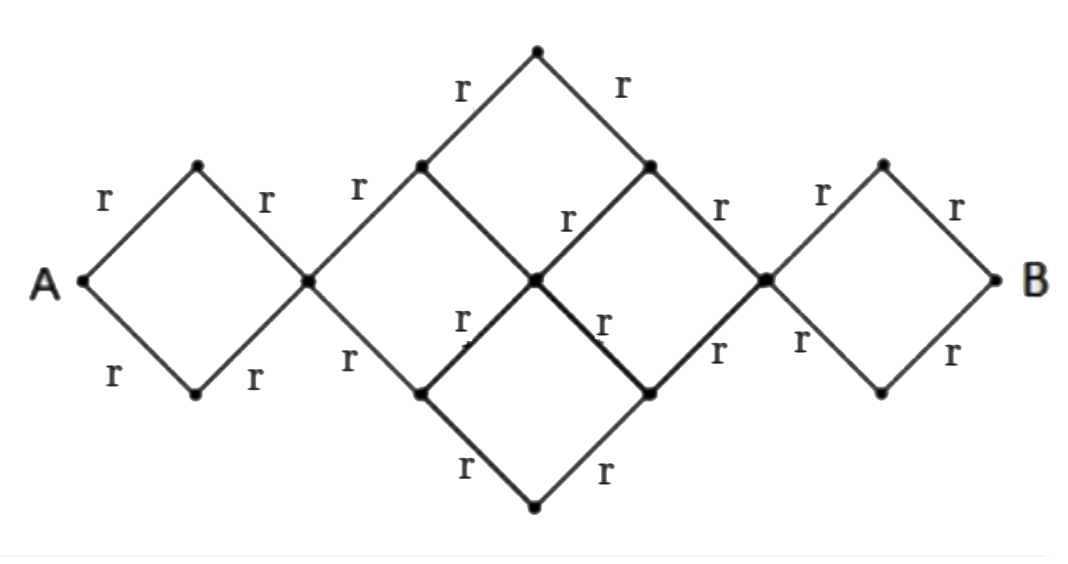A uniform wire is cut into 10 segments of increasing length. Each segment is having a resistace of 8 Ω more than that of previous segment. If the resistance of shortest segment is R and largest segment is 2 R. The original resistance of wrie in ohm.
72
144
720
1080
The correct Answer is:D
To solve the problem, we need to determine the original resistance of the wire based on the given conditions. Here’s a step-by-step solution:
Step 1: Define the resistances of the segments
Let the resistance of the shortest segment be R. According to the problem, each subsequent segment has a resistance that is 8Ω more than the previous segment. Therefore, the resistances of the segments can be expressed as follows:
1. First segment: R
2. Second segment: R+8
3. Third segment: R+16
4. Fourth segment: R+24
5. Fifth segment: R+32
6. Sixth segment: R+40
7. Seventh segment: R+48
8. Eighth segment: R+56
9. Ninth segment: R+64
10. Tenth segment: R+72
Step 2: Relate the largest segment to R
According to the problem, the resistance of the largest segment (the tenth segment) is 2R. Thus, we can set up the equation:
R+72=2R
Step 3: Solve for R
Rearranging the equation gives:
72=2R−R
72=R
So, the resistance of the shortest segment R is 72Ω.
Step 4: Calculate the total resistance of the wire
Now, we need to find the total resistance of the wire, which is the sum of the resistances of all segments. The resistances of the segments can be expressed as an arithmetic progression (AP) where:
- First term a=R=72
- Common difference d=8
- Number of terms n=10
The last term (tenth term) can be calculated as:
an=a+(n−1)d=72+(10−1)⋅8=72+72=144Ω
Step 5: Use the formula for the sum of an arithmetic series
The sum Sn of the first n terms of an arithmetic series is given by:
Sn=n2×(a+an)
Substituting the values we have:
S10=102×(72+144)=5×216=1080Ω
Final Answer
The original resistance of the wire is 1080Ω.
---
Let the resistance of the shortest segment be R. According to the problem, each subsequent segment has a resistance that is 8Ω more than the previous segment. Therefore, the resistances of the segments can be expressed as follows:
2. Second segment: R+8
3. Third segment: R+16
4. Fourth segment: R+24
5. Fifth segment: R+32
6. Sixth segment: R+40
7. Seventh segment: R+48
8. Eighth segment: R+56
9. Ninth segment: R+64
10. Tenth segment: R+72
According to the problem, the resistance of the largest segment (the tenth segment) is 2R. Thus, we can set up the equation:
Rearranging the equation gives:
72=R
Now, we need to find the total resistance of the wire, which is the sum of the resistances of all segments. The resistances of the segments can be expressed as an arithmetic progression (AP) where:
- Common difference d=8
- Number of terms n=10
The sum Sn of the first n terms of an arithmetic series is given by:
The original resistance of the wire is 1080Ω.
Topper's Solved these Questions
- APPENDICES ( REVISION EXERCISE )BOOK - AAKASH SERIESCHAPTER - APPENDICES ( REVISION EXERCISE )EXERCISE - REVISION EXERCISE (MOVING CHANGES & MEGNETISM)
95 Videos
- APPENDICES ( REVISION EXERCISE )BOOK - AAKASH SERIESCHAPTER - APPENDICES ( REVISION EXERCISE )EXERCISE - REVISION EXERCISE (MAGNETISM AND MATTER )
52 Videos
- APPENDICES ( REVISION EXERCISE )BOOK - AAKASH SERIESCHAPTER - APPENDICES ( REVISION EXERCISE )EXERCISE - REVISION EXERCISE (ELECTRIC POTENTIAL & CAPACITANCE )
143 Videos
- ALTERNATING CURRENTBOOK - AAKASH SERIESCHAPTER - ALTERNATING CURRENTEXERCISE - EXERCISE - III
24 Videos
- APPENDICES (REVISION EXERCISE)BOOK - AAKASH SERIESCHAPTER - APPENDICES (REVISION EXERCISE)EXERCISE - LAW OF MOTION
128 Videos
Similar Questions
Knowledge Check
A potentiometer wire of length 100cm has a resistance of 10Ω. It is connected in series with a resistance and a cell of emf 2V and of negligible interal resistance. A source of emf 10mV is balanced against a length of 40cm of the potentiometer wire. What is the value of external resistance?
A790ΩB890ΩC990ΩD1090Ω
The resistance of a wire is R ohm. If it is melted and stretched to n times its original length, its new resistance will be
View SolutionDivide a line segment of length 10cm internally in the ratio 3:2
View SolutionDraw a line segment of length 8.6 cm. Bisect it and measure the length of each part.
View SolutionDraw a line segment of length 8.6cm. Bisect it and measure the length of each part.
View SolutionDraw a line segment of length 8 cm and divides it in the ratio 2:3
View SolutionA potentiometer wire of length 100cm having a resistance of 10Ω is connected in series with a resistance R and a cell of emf 2V of negligible internal resistance. A source of emf

of 10mV is balanced against a length of 40cm of the potentiometer wire. What is the value of resistance R ?
View SolutionA potentiometer wire of length 100cm having a resistance of 10Ω is connected in series with a resistance R and a cell of emf 2V of negligible internal resistance. A source of emf

of 10mV is balanced against a length of 40cm of the potentiometer wire. What is the value of resistance R ?
View Solution

